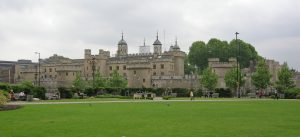
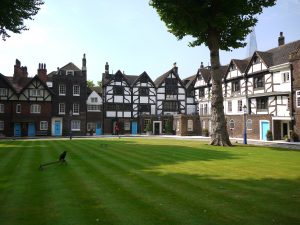




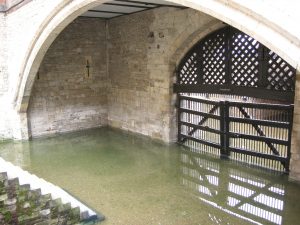
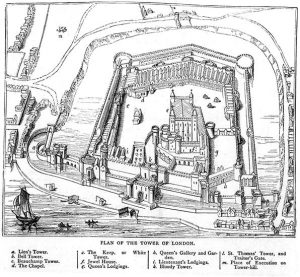
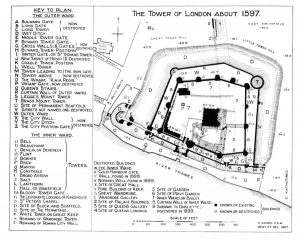
Images: Panorama view of the Tower complex; Tower Green governor’s quarters; White Tower from south; detail of Tudor-era cupola added to White Tower; exterior of St. Peter ad Vincula chapel; interior of St. Peter ad Vincula chapel; water gate (all photos by C.A. Stanford); aerial drawing of the Tower of London, 1597 (Photo courtesy https://commons.wikimedia.org/wiki/File:Tower_plan.JPG); ground plan of the Tower of London, 1597 (Photo courtesy https://www.theanneboleynfiles.com/resources/anne-boleyn-places/the-tower-of-london-in-annes-life/).
Acquired: 1509 (by inheritance)
The Tower of London was, and is, an iconic structure of the Crown. A large castle complex begun by William the Conqueror to subdue the City of London, its core is the White Tower, but additional towers and curtain walls were added throughout the medieval period. Very little of its current fabric dates from the Tudor years, although the chapel of St. Peter ad Vincula was rebuilt within its walls in 1520, and the White Tower’s four corner turrets received their “onion-dome” cupolas within Henry’s era. A new Jewel House also was built between the north side of the Great Hall and the south side of the White Tower in 1540 (although this does not survive.) The king’s craftsmen also undertook various repairs, refurbishments and temporary structures (like the jousting “tilt” erected early in Henry’s reign).
By Henry VIII’s time, the Tower had ceased to be a major royal residence, though it still had some ceremonial functions; for instance, it was tradition for monarchs to stay at the Tower before their coronations. Henry’s second wife Anne Boleyn did so, in newly refurbished apartments, before her coronation on 1 June 1533. The Tower also, of course, served as a prison and, upon occasion, execution site for high-status figures. Queen Anne was lodged at the Tower before her execution on 19 May 1536, which took place on Tower Green, within the castle walls. Henry’s fifth wife, Catherine Howard, was also executed at the Tower, on 13 February 1542. Both queens were buried in unmarked graves at the chapel of St. Peter ad Vincula.
*Click here to see the women vendors that worked at this site.